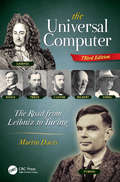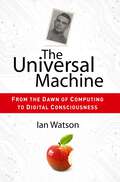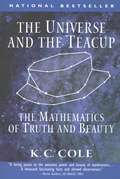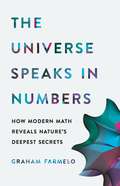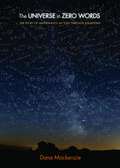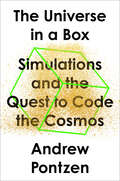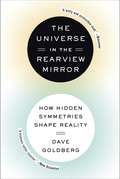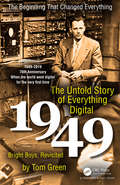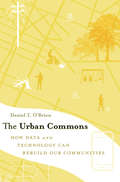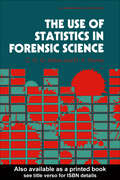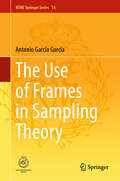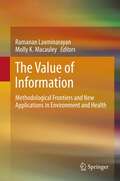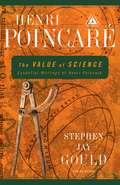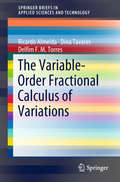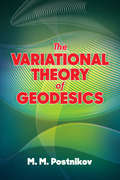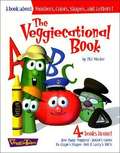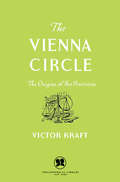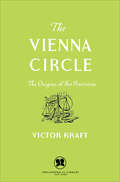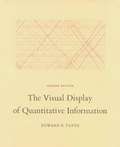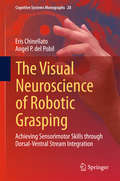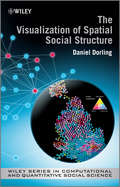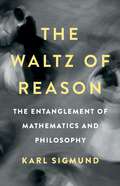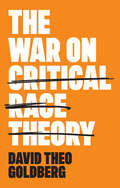- Table View
- List View
The Universal Computer: The Road from Leibniz to Turing, Third Edition
by Martin DavisThe breathtakingly rapid pace of change in computing makes it easy to overlook the pioneers who began it all. The Universal Computer: The Road from Leibniz to Turing explores the fascinating lives, ideas, and discoveries of seven remarkable mathematicians. It tells the stories of the unsung heroes of the computer age – the logicians.
The Universal Machine
by Ian WatsonThe computer unlike other inventions is universal; you can use a computer for many tasks: writing, composing music, designing buildings, creating movies, inhabiting virtual worlds, communicating... This popular science history isn't just about technology but introduces the pioneers: Babbage, Turing, Apple's Wozniak and Jobs, Bill Gates, Tim Berners-Lee, Mark Zuckerberg. This story is about people and the changes computers have caused. In the future ubiquitous computing, AI, quantum and molecular computing could even make us immortal. The computer has been a radical invention. In less than a single human life computers are transforming economies and societies like no human invention before.
The Universe And The Teacup: The Mathematics of Truth and Beauty
by K. C. ColeFilled with “a thousand fascinating facts and shrewd observations (Martin Gardner, Los Angeles Times), this “beguiling and lucid book” (San Francisco Chronicle) demonstrates how the truth and beauty of everything, from relativity to rainbows, is all in the numbers. Line drawings.
The Universe Speaks in Numbers: How Modern Math Reveals Nature's Deepest Secrets
by Graham FarmeloHow math helps us solve the universe's deepest mysteries One of the great insights of science is that the universe has an underlying order. The supreme goal of physicists is to understand this order through laws that describe the behavior of the most basic particles and the forces between them. For centuries, we have searched for these laws by studying the results of experiments. Since the 1970s, however, experiments at the world's most powerful atom-smashers have offered few new clues. So some of the world's leading physicists have looked to a different source of insight: modern mathematics. These physicists are sometimes accused of doing 'fairy-tale physics', unrelated to the real world. But in The Universe Speaks in Numbers, award-winning science writer and biographer Farmelo argues that the physics they are doing is based squarely on the well-established principles of quantum theory and relativity, and part of a tradition dating back to Isaac Newton. With unprecedented access to some of the world's greatest scientific minds, Farmelo offers a vivid, behind-the-scenes account of the blossoming relationship between mathematics and physics and the research that could revolutionize our understanding of reality. A masterful account of the some of the most groundbreaking ideas in physics in the past four decades. The Universe Speaks in Numbers is essential reading for anyone interested in the quest to discover the fundamental laws of nature.
The Universe in Zero Words
by Dana MackenzieMost popular books about science, and even about mathematics, tiptoe around equations as if they were something to be hidden from the reader's tender eyes. Dana Mackenzie starts from the opposite premise: He celebrates equations. No history of art would be complete without pictures. Why, then, should a history of mathematics--the universal language of science--keep the masterpieces of the subject hidden behind a veil?The Universe in Zero Words tells the history of twenty-four great and beautiful equations that have shaped mathematics, science, and society--from the elementary (1+1=2) to the sophisticated (the Black-Scholes formula for financial derivatives), and from the famous (E=mc2) to the arcane (Hamilton's quaternion equations). Mackenzie, who has been called "a popular-science ace" by Booklist magazine, lucidly explains what each equation means, who discovered it (and how), and how it has affected our lives.Illustrated in color throughout, the book tells the human and often-surprising stories behind the invention or discovery of the equations, from how a bad cigar changed the course of quantum mechanics to why whales (if they could communicate with us) would teach us a totally different concept of geometry. At the same time, the book shows why these equations have something timeless to say about the universe, and how they do it with an economy (zero words) that no other form of human expression can match.The Universe in Zero Words is the ultimate introduction and guide to equations that have changed the world.
The Universe in a Box: Simulations and the Quest to Code the Cosmos
by Andrew PontzenScientists are using simulations to recreate the universe, revealing the hidden nature of reality.Cosmology is a tricky science—no one can make their own stars, planets, or galaxies to test its theories. But over the last few decades a new kind of physics has emerged to fill the gap between theory and experimentation. Harnessing the power of modern supercomputers, cosmologists have built simulations that offer profound insights into the deep history of our universe, allowing centuries-old ideas to be tested for the first time. Today, physicists are translating their ideas and equations into code, finding that there is just as much to be learned from computers as experiments in laboratories. In The Universe in a Box, cosmologist Andrew Pontzen explains how physicists model the universe&’s most exotic phenomena, from black holes and colliding galaxies to dark matter and quantum entanglement, enabling them to study the evolution of virtual worlds and to shed new light on our reality. But simulations don&’t just allow experimentation with the cosmos; they are also essential to myriad disciplines like weather forecasting, epidemiology, neuroscience, financial planning, airplane design, and special effects for summer blockbusters. Crafting these simulations involves tough compromises and expert knowledge. Simulation is itself a whole new branch of science, one that we are only just beginning to appreciate and understand. The story of simulations is the thrilling history of how we arrived at our current knowledge of the world around us, and it provides a sneak peek at what we may discover next.
The Universe in the Rearview Mirror
by Dave GoldbergA physicist speeds across space, time and everything in between showing that our elegant universe--from the Higgs boson to antimatter to the most massive group of galaxies--is shaped by hidden symmetries that have driven all our recent discoveries about the universe and all the ones to come. Why is the sky dark at night? Is it possible to build a shrink-ray gun? If there is antimatter, can there be antipeople? Why are past, present, and future our only options? Are time and space like a butterfly's wings? No one but Dave Goldberg, the coolest nerd physicist on the planet, could give a hyper drive tour of the universe like this one. Not only does he answer the questions your stoner friends came up with in college, but he also reveals the most profound discoveries of physics with infectious, Carl Sagan-like enthusiasm and accessibility. Goldberg's narrative is populated with giants from the history of physics, and the biggest turns out to be an unsung genius and Nazi holocaust escapee named Emmy Noether--the other Einstein. She was unrecognized, even unpaid, throughout most of her career simply because she was a woman. Nevertheless, her theorem relating conservation laws to symmetries is widely regarded to be as important as Einstein's notion of the speed of light. Einstein himself said she was "the most significant creative mathematical genius thus far produced since the higher education of women began." Symmetry is the unsung great idea behind all the big physics of the last one hundred years--and what lies ahead. In this book, Goldberg makes mindbending science not just comprehensible but gripping. Fasten your seat belt.
The Untold Story of Everything Digital: Bright Boys, Revisited (AK Peters/CRC Recreational Mathematics Series)
by Tom GreenThe Untold Story of Everything Digital: Bright Boys, Revisited celebrates the 70th anniversary (1949-2019) of the world "going digital" for the very first time—real-time digital computing’s genesis story. That genesis story is taken from the 2010 edition of Bright Boys: The Making of Information Technology, 1938-1958, and substantially expanded upon for this special, anniversary edition. Please join us for the incredible adventure that is The Untold Story of Everything Digital, when a band of misfit engineers, led by MIT's Jay Forrester and Bob Everett, birthed the digital revolution. The bright boys were the first to imagine an electronic landscape of computing machines and digital networks, and the first to blaze its high-tech trails.
The Urban Commons: How Data and Technology Can Rebuild Our Communities
by Daniel T. O'BrienThrough voicemail, apps, websites, and Twitter, Boston’s sophisticated 311 system allows citizens to report potholes, broken streetlights, graffiti, and vandalism that affect everyone’s quality of life. Drawing on Boston’s rich data, Daniel T. O’Brien offers a model of what smart technology can do for cities seeking both growth and sustainability.
The Use Of Statistics In Forensic Science
by C. G. Aitken David A. StoneyDescribes ways of assessing forensic science evidence and the means of communicating the assessment to a court of law. The aim of this work is to ensure that the courts consider seriously the probability of the evidence of association.
The Use of Frames in Sampling Theory (RSME Springer Series #14)
by Antonio García GarcíaThis book provides a comprehensive review of regular sampling based on frame theory in a separable Hilbert space. Thus, sampling theory has common features in almost all situations: classical theory, Kramer sampling theory, and finite sampling or sampling Hilbert–Schmidt operators. In addition, the transversality of sampling theory with other mathematical fields appears, in an easy way. The first three chapters of the book can be used as an introduction to sampling theory, while the rest of the chapters are addressed to introduce the interested reader in the research on the topic.
The Value of Information: Methodological Frontiers and New Applications in Environment and Health
by Ramanan Laxminarayan Molly K. MacauleyThe book examines applications in two disparate fields linked by the importance of valuing information: public health and space. Researchers in the health field have developed some of the most innovative methodologies for valuing information, used to help determine, for example, the value of diagnostics in informing patient treatment decisions. In the field of space, recent applications of value-of-information methods are critical for informing decisions on investment in satellites that collect data about air quality, fresh water supplies, climate and other natural and environmental resources affecting global health and quality of life.
The Value of Science: Essential Writings of Henri Poincare (Modern Library Science)
by Henri PoincaréMore than any other writer of the twentieth century, Henri Poincaré brought the elegant, but often complicated, ideas about science and mathematics to the general reader. A genius who throughout his life solved complex mathematical calculations in his head, and a writer gifted with an inimitable style, Poincaré rose to the challenge of interpreting the philosophy of science to scientists and nonscientists alike. His lucid and welcoming prose made him the Carl Sagan of his time. This volume collects his three most important books: Science and Hypothesis (1903); The Value of Science (1905); and Science and Method (1908).
The Variable-Order Fractional Calculus of Variations (SpringerBriefs in Applied Sciences and Technology)
by Delfim F. M. Torres Ricardo Almeida Dina TavaresThe Variable-Order Fractional Calculus of Variations is devoted to the study of fractional operators with variable order and, in particular, variational problems involving variable-order operators. This brief presents a new numerical tool for the solution of differential equations involving Caputo derivatives of fractional variable order. Three Caputo-type fractional operators are considered, and for each one, an approximation formula is obtained in terms of standard (integer-order) derivatives only. Estimations for the error of the approximations are also provided. The contributors consider variational problems that may be subject to one or more constraints, where the functional depends on a combined Caputo derivative of variable fractional order. In particular, they establish necessary optimality conditions of Euler–Lagrange type. As the terminal point in the cost integral is free, as is the terminal state, transversality conditions are also obtained.The Variable-Order Fractional Calculus of Variations is a valuable source of information for researchers in mathematics, physics, engineering, control and optimization; it provides both analytical and numerical methods to deal with variational problems. It is also of interest to academics and postgraduates in these fields, as it solves multiple variational problems subject to one or more constraints in a single brief.
The Variational Theory of Geodesics (Dover Books on Mathematics)
by M. M. PostnikovRiemannian geometry is a fundamental area of modern mathematics and is important to the study of relativity. Within the larger context of Riemannian mathematics, the active subdiscipline of geodesics (shortest paths) in Riemannian spaces is of particular significance. This compact and self-contained text by a noted theorist presents the essentials of modern differential geometry as well as basic tools for the study of Morse theory. The advanced treatment emphasizes analytical rather than topological aspects of Morse theory and requires a solid background in calculus.Suitable for advanced undergraduates and graduate students of mathematics, the text opens with a chapter on smooth manifolds, followed by a consideration of spaces of affine connection. Subsequent chapters explore Riemannian spaces and offer an extensive treatment of the variational properties of geodesics and auxiliary theorems and matters.
The Veggiecational Book: A Book About Numbers, Colors, Shapes And Letters! (VeggieTales)
by Phil VischerThe Veggiecational Book from Big Idea's "VeggieTales" cast of characters. This 4-in-1 volume includes the full text of Bob & Larry's ABC's, How Many Veggies?, Pa Grape's Shapes, and Junior's Colors.
The Very Berry Counting Book (Jerry Pallotta's Counting Books)
by Jerry Pallotta"Children can learn to count from one to 10 in a berry appetizing way. This lovely counting book, reminiscent of old-fashioned botanical illustrations, introduces children to a variety of berries." -Kirkus ReviewsBest-selling author Jerry Pallotta&’s latest counting book is for the youngest readers to devour. Covering familiar North American berries like blueberries and strawberries, as well as lesser-known ones such as mul-berries and salmonberries, this fruity board book combines evocative adjectives with berry names, numbers, and colors in a sweet and simple way. Joy Newton&’s botanical illustrations bring a vintage farm-stand feel to each page. Berries are a healthy finger food toddlers are familiar with. Learning their names and the numbers from one to ten is sure to delight.
The Vexing Case of Igor Shafarevich, a Russian Political Thinker
by Krista BerglundThis is the first comprehensive study about the non-mathematical writings and activities of the Russian algebraic geometer and number theorist Igor Shafarevich (b. 1923). In the 1970s Shafarevich was a prominent member of the dissidents' human rights movement and a noted author of clandestine anti-communist literature in the Soviet Union. Shafarevich's public image suffered a terrible blow around 1989 when he was decried as a dangerous ideologue of anti-Semitism due to his newly-surfaced old manuscript Russophobia. The scandal culminated when the President of the National Academy of Sciences of the United States suggested that Shafarevich, an honorary member, resign. The present study establishes that the allegations about anti-Semitism in Shafarevich's texts were unfounded and that Shafarevich's terrible reputation was cemented on a false basis.
The Vienna Circle: The Origins of Neo-Positivism
by Victor KraftJoin original Vienna Circle member Victor Kraft in his discussion of the movement for an exclusive insider&’s view of this important point in philosophical history. In this in-depth philosophical study, Victor Kraft explores the role the Vienna Circle had on the international philosophical movement. The Vienna Circle constituted a point of departure for the reawaking, rebirth, and reformation of positivism and empiricism, leading to the creation of the Neo-positivism movement. At the time of The Vienna Circle&’s publication in the 1950s, the Neo-positivism movement stood in the foreground of contemporary philosophy, and it was quite possibly the most significant serious philosophical movement in the period between the two world wars. Making Kraft&’s study of Neo-positivism available to a world audience, Arthur Pap provides a rich and accessible translation from the original German. The book contains detailed expositions, accompanied here and there by criticism, of the Vienna Circle&’s views on the criteria of significance, the nature of logic and mathematics, the phenomenalist analysis of physical concepts, the verification-basis of scientific propositions, the meaning of probability, physicalism, and much more.
The Vienna Circle: The Origins of Neo-Positivism
by Victor KraftA member of the elite group who helped forge the logical positivism movement delves into the intellectual world of early-twentieth-century Vienna. Drawing together some of the greatest minds in Europe during the 1920s and 30s, the Vienna Circle had a profound influence on contemporary science and philosophy. Thinkers such as Moritz Schlick, Gustav Bergmann, and Karl Menger met regularly at the University of Vienna to discuss the philosophy of science, taking inspiration from such pioneering works as Ludwig Wittgenstein&’s Tractatus Logico-Philosophicus and Alfred North Whitehead and Bertrand Russell&’s Principia Mathematica. In this in-depth study, Vienna Circle member Victor Kraft explores this group&’s role in the development of modern thought. The Vienna Circle constituted a point of departure for the rebirth and reformation of positivism and empiricism, leading to the creation of the Neo-positivism movement. At the time of publication in the 1950s, the neopositivism movement stood in the foreground of contemporary philosophy, and it was quite possibly the most significant philosophical movement between the two world wars. Making Kraft&’s study of neopositivism available to a world audience, Arthur Pap provides a rich and accessible translation from the original German publication.</
The Visual Display of Quantitative Information
by Edward TufteThe classic book on statistical graphics, charts, tables. Theory and practice in the design of data graphics, 250 illustrations of the best (and a few of the worst) statistical graphics, with detailed analysis of how to display data for precise, effective, quick analysis. Design of the high-resolution displays, small multiples. Editing and improving graphics. The data-ink ratio. Time-series, relational graphics, data maps, multivariate designs. Detection of graphical deception: design variation vs. data variation. Sources of deception. Aesthetics and data graphical displays. This is the second edition of The Visual Display of Quantitative Information. Recently published, this new edition provides excellent color reproductions of the many graphics of William Playfair, adds color to other images, and includes all the changes and corrections accumulated during 17 printings of the first edition.
The Visual Neuroscience of Robotic Grasping
by Eris Chinellato Angel P. PobilThis book presents interdisciplinary research that pursues the mutual enrichment of neuroscience and robotics. Building on experimental work, and on the wealth of literature regarding the two cortical pathways of visual processing - the dorsal and ventral streams - we define and implement, computationally and on a real robot, a functional model of the brain areas involved in vision-based grasping actions. Grasping in robotics is largely an unsolved problem, and we show how the bio-inspired approach is successful in dealing with some fundamental issues of the task. Our robotic system can safely perform grasping actions on different unmodeled objects, denoting especially reliable visual and visuomotor skills. The computational model and the robotic experiments help in validating theories on the mechanisms employed by the brain areas more directly involved in grasping actions. This book offers new insights and research hypotheses regarding such mechanisms, especially for what concerns the interaction between the dorsal and ventral streams. Moreover, it helps in establishing a common research framework for neuroscientists and roboticists regarding research on brain functions.
The Visualisation of Spatial Social Structure
by Danny DorlingHow do you draw a map of 100,000 places, of more than a million flows of people, of changes over time and space, of different kinds of spaces, surfaces and volumes, from human travel time to landscapes of hopes, fears, migration, manufacturing and mortality? How do you turn the millions of numbers concerning some of the most important moments of our lives into images that allow us to appreciate the aggregate while still remembering the detail?The visualization of spatial social structure means, literally, making visible the geographical patterns to the way our lives have come to be socially organised, seeing the geography in society. To a statistical readership visualization implies using data. More widely defined it implies freeing our imaginations.The Visualization of Spatial Social Structure introduces the reader to new ways of thinking about how to look at social statistics, particularly those about people in places. The author presents a unique combination of statistical focus and understanding of social structures and innovations in visualization, describing the rationale for, and development of, a new way of visualizing information in geographical research. These methods are illustrated through extensive full colour graphics; revealing mistakes, techniques and discoveries which present a picture of a changing political and social geography. More complex aspects on the surface of social landscapes are revealed with sculptured symbols allowing us to see the relationships between the wood and the trees of social structure. Today's software can be so flexible that these techniques can now be emulated without coding.This book centres on a particular place and time; 1980s Britain, and a particular set of records; routine social statistics. A great deal of information about the 80s' social geography of Britain is contained within databases such as the population censuses, surveys and administrative data. Following the release of the 2011 census, now is a good time to look back at the past to introduce many new visualization techniques that could be used by future researchers.
The Waltz of Reason: The Entanglement of Mathematics and Philosophy
by Karl Sigmund"A mind-bending jaunt ... that makes clear in fascinating detail how math is more than a sum of its parts" (Publishers Weekly) &“Let no one ignorant of geometry enter here,&” Plato warned would-be philosophers. Mathematician Karl Sigmund agrees. In The Waltz of Reason, he shows how mathematics and philosophy together have shaped our understanding of space, chance, logic, cooperation, voting, and the social contract. Sigmund shows how game theory is integral to moral philosophy, how statistics shaped the meaning of reason, and how the search for a logical basis for math leads to deep questions about the nature of truth itself. But this is no dry tome: Sigmund&’s wit and humor shine as brightly as his erudition.The Waltz of Reason is an engrossing history of ideas as vibrant as a ballroom full of dancers, one that empowers as it entertains, following the complex and occasionally dizzying steps of the thinkers who have molded our thought and founded our world.
The War on Critical Race Theory: Or, The Remaking of Racism
by David Theo Goldberg“Critical Race Theory” is consuming conservative America. The mounting attacks on a once-obscure legal theory are upending public schooling, legislating censorship, driving elections, and cleaving communities. In this much-needed response, renowned scholar David Theo Goldberg cuts to the heart of the claims expressed in these attacks. He punctures the demonization of Critical Race Theory, uncovering who is orchestrating it, funding the assault, and eagerly distributing the message. The book richly illustrates the enduring nature of structural racism, even as a conservative insistence on colorblindness serves to silence the possibility of doing anything about it. Crucially, Goldberg exposes the political aims and effects of the vitriolic attacks. The upshot of CRT’s targeting, he argues, has been to unleash racisms anew and to stymie any attempt to fight them, all with the aim of protecting white minority rule.
